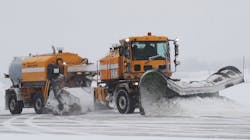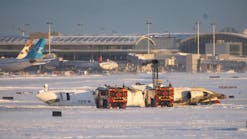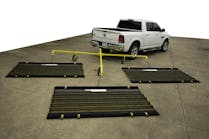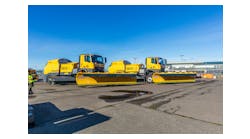The Buffalo Niagara International Airport (BUF) sees on average 90 to 100 inches of snow a year and is one of the busiest snowbelt airports in the world, said Joseph Guarino, BUF’s airfield superintendent.
“I challenge my staff on a regular basis. I tell them, ‘That next aircraft to land, it has your children on board. Is that runway safe for that aircraft to land?’ And that's how we stay on top of it. If you operate in that pretense, you're 100% every time,” said Guarino.
To move all that snow requires preparation well in advance. Guarino’s team starts during the dry season far ahead of the first snowfall.
“Obviously planning is huge in the non-winter months so you're ready for it when we actually do have weather here. We prepare, we train our staff. No employee even gets in a piece of equipment until they know the airfield like the back of their hand. So, they have to get trained out on the airfield, the movement area we call it, so you're able to communicate with the air traffic control tower and know the airport like you know your own town's roads. That happens at the very onset of a person's career here in Buffalo Niagara International airport,” Guarino said.
The practice is needed to keep the crew fresh for when snow will actually fall, as depending on when the winter season ends, it can be months between when their equipment is needed to move actual snow.
“So, it's good to get them back in there and get everything going through its paces. We also go through tabletop drills. We do other various exercises. We have recurrent training every year too which is required by the FAA. We go through all the movement area training and communication, and also again, re-familiarization with the equipment. It's every day we're doing something to maintain our vigilance out there,” Guarino continued.
He said that they have over 30 pieces of snow removal equipment – with the stars of the show being BUF’s newly acquired MB5s, manufactured by M-B Companies, Inc. This winter is the first the airport has put the multitask equipment.
“That is the latest and greatest that's out there. It basically does the work of two pieces of equipment with one because you have a plow and a broom, and then the high speed air blast basically cleans the pavement in one pass,” said Guarino of their five MB5s.
The equipment takes only when operator to work and are nearly large enough to do the entire width of the runway in one pass. In addition to the MB5s, they also have variety of other piece of equipment, such as snow blowers, other plows for the taxiways and front-mounted brooms that clean the pavement.
Getting trained to use all the equipment is the first order for business when new hires are brought on board.
“The people, when they're trained on the airfield, that's the first part of their training,” said Guarino. “Depending upon their background, we like to hire folks who have background in operating heavy duty diesel equipment and especially airport equipment because they're a unique type of equipment. You don't find that at any Main Street, USA.”
BUF also maintains its own equipment with onsite mechanics.
“We have mechanics. We maintain our own equipment. They go through all the equipment. They'll do all the fluid changes, any maintenance items, and go through it from soup to nuts, make sure everything's up and running,” Guarino said.
It’s Snow Problem
With gear in hand, trained and prepared on during the off season, Guarino and his team are ready for when winter weather descends upon the airport. The weather forecast is checked regularly, and as a storm begins to brew, that becomes hourly.
“The main folks we speak to is National Weather Service. They have a station here at Buffalo. Once we get a good handle on the forecast, that they're basically saying it's 100% chance we're going to get eight to 12 inches over the next 36 hours, then we usually have a stakeholder's meeting,” described Guarino.
At the meeting, the forecast is gone over and they have the National Weather Service send them a briefing on what can be expected such as temperature and wind changes.
“Are we going to have cold temperatures where we'll probably have more lighter, less moisture in the snow, easier to remove? Are we going to have the more heavy, wet snow?” Guarino said.
This season, the airport has been getting hit with more ice storms than usual. As of March, Guarino said they had experienced about 19 ice events since Nov. 15 and he said dealing with ice can very taxing.
“What we use on is liquid chemical deicer. We have two 4000 gallon tankers that have booms on them, 50-foot booms. We can basically do the width of each runway surface in one pass. Depending on the situation, we can anti-ice before the storm hits or we deice which brings up the surface temperature, so it basically gives us a bare surface. As the FAA advisory circular dictates to us, you want the airfield conditions to be no worse than wet. That's the ideal condition and we try to meet that during our operations as we get into it,” Guarino described.
With years of experience under their belt and year-round practice, Guarino said BUF has snow removal down to somewhat of a science, but with the wisdom to also know no two storms are alike.
“They're always different. I mean, you could start out 20 degrees, winds gusty, near whiteout conditions over time, and then it starts warming up and then now you have a heavier, wet snow and you got a different operation. You could start off with just brooming the runway surface and now you're plowing it and using blowers,” he said.
Predicting the weather can be the most challenging part of BUF’s snow removal operations. Given their location, BUF is prone to lake effect snow, which can be in addition the regularly forecasted storm.
“Because of our location, you have the lake effect, and then you could have a storm front coming across the country. You get that, and once the storm passes, and then we're so lucky we get the lake effect after depending upon the wind. So, we could get a double whammy. That's one of the bigger challenges, and especially when they say it should be over two hours ago and we still getting another two to three inches an hour,” Guarino said.
For their work, BUF has won nine Balchen/Post Awards, six while under Guarino’s supervision, which are given out for excellence in snow removal at the every year at the International Aviation Snow Symposium.
“Everybody works together as a team. If there's any issues, if we had an aircraft needs to land here, has a medical emergency on board, we're doing all we can to keep that runway clear and get that aircraft in here. We pride ourselves in keeping the airport open and safe,” Guarino said.
Airfield Software Solutions
For those without 100 inches of snow to clear a year, streamlining airfield operations can be as simple as opening a tablet. the Arora ATLAS suite of mobile products consists of six individual modules Brian Benedict, development director - enterprise solutions, Arora, said that the suite of applications was designed to bring the many different smart applications and airport may have, such as airfield lighting or their HVAC system, under one roof.
Five of them are based in the application, with the sixth a web-based work request tool.
“There's what we call Fix. That's the work order management module. There's Inspect, which does, not only Part 139 airfield inspections, but really life safety inspections, HVAC inspections, for example. There's an inventory module we call Supply, which connects to whatever the backend inventory management software, whether it's Maximo, or another third party software that the airport might be using. Then the last two modules are what are called Connect and Insights.”
So what that's designed to do is those two modules designed to provide a single pane of glass for the airport to really connect all of their smart and connected building systems,” Benedict said.
Operations on the airfield side are broken down into three categories in the software. Surfaces, such as runways, taxiways, ramps, grass islands; lights and signs; and then roads and fencing.
One of the greater benefits of ATLAS on the inspection side is that it’s heavily integrated with GIS and location services.
“Obviously, we know most airports are making huge investments in GIS technology, and getting the GIS technology linked with the asset data, and then pushing that critical information out to that technician. This airfield light, a pilot reports that it's out. To know exactly where that light is, exactly what model it is, exactly what parts need to be done, that's where the gap is today. We know that everybody's trying to do more with less. So, if I can send you, as a technician, directly to that light, or directly to that crack in the pavement, with the proper tools, and the proper materials, with a detailed inspection, or whatever stage you're in, that just drives a tremendous amount of efficiency for the airport,” Benedict said.






